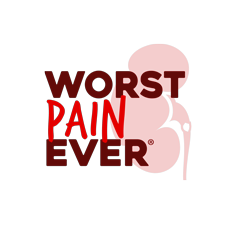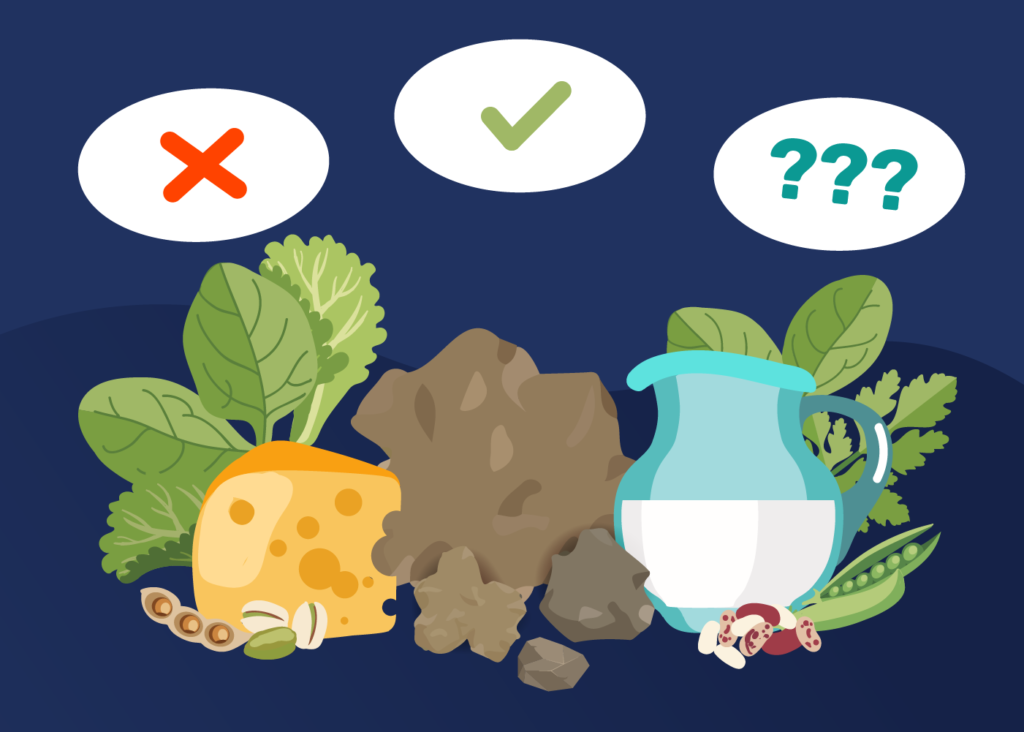Calcium oxalate stone formers, you may have been avoiding dairy like the plague. While cutting calcium entirely from your diet may seem like the most logical step to make, it can actually hinder your attempts to prevent kidney stones! Here’s how you can have your milk and drink it too.
*Disclaimer: Kidney stones are caused by many factors and may be influenced by genetic and environmental factors including diet. This information is general dietary advice for kidney stone formers in whom no specific causes are known.
What is calcium, and how does it contribute to the formation of kidney stones?
Calcium is a mineral that helps build strong bones. It also plays other important roles in blood clotting, helping muscles to contract, and maintaining heart and nerve functions. Some high-calcium foods you may be familiar with are yogurt, cheese, salmon, and calcium-fortified orange juice (this is usually stated on the bottle labels!)1.
Despite its benefits, calcium has a bad reputation in the kidney stone community due to misconceptions about its role in the formation of kidney stones, particularly calcium oxalate stones.
Calcium oxalate stones are solid masses that form in the kidney when there are exceptionally high levels of calcium and oxalate in the urine2.
Does that mean I should stop eating and drinking foods that contain calcium?
No! In fact, maintaining a healthy daily intake of calcium may lower your risk of kidney stone formation.
In 1993, a landmark study of 45,619 men showed that high dietary calcium intake (from food, instead of calcium supplements) reduced the risk of symptomatic kidney stones3.
Since then, multiple studies have confirmed that dietary calcium intake helps to protect against stone formation1!
Wait, how does calcium help to prevent kidney stones?
When you eat foods that contain calcium and oxalate during the same meal, they bind together to form a calcium-oxalate complex. This reduces the amount of free oxalate that is absorbed into your intestines, and later excreted in your urine. Simply put, a lower urinary excretion of oxalate may lower your chances of forming calcium oxalate stones6!
For you, that means mixing up your diet. If you’re planning to snack on cashews or walnuts, have them with some yogurt!
Well, what happens if I completely cut out calcium from my diet?
There’s a reason you were told to drink a lot of milk as a child! Calcium is an important part of your diet, even for kidney stone formers. As 98% of your body’s calcium is stored in your bones1, going cold turkey on calcium can lead to reduced bone strength and even osteoporosis, amongst other bone disorders.
Some patients may even develop a more serious deficiency of calcium called hypocalcemia. It is usually caused by diseases such as kidney failure, or medications such as diuretics7.
Some symptoms of hypocalcemia include muscle cramps or weakness, abnormal heart rate, and poor appetite⁶. That is why an average adult is generally recommended to consume around 1,000mg of calcium as part of their daily diet1, which is around five cups of milk, or two cups of plain low-fat yogurt.
I hate drinking milk. Can I rely on calcium supplements instead?
We recommend speaking to your physician about it first! It is generally recommended that you take these supplements with your meals, as taking them outside of mealtime may increase your risks of kidney stone formation instead1.
An excess of calcium, called hypercalcemia, (the opposite of hypocalcemia), can also be dangerous, leading to constipation, kidney stones, and even heart problems.
So, as a kidney stone former, how can I ensure I’m getting a healthy amount of calcium in my diet?
According to the National Institutes of Health, the ideal calcium intake for adults aged 31 to 70 years old are as follows⁸:
Life-stage group | mg/day |
19 to 50 years old, pregnant/lactating | 1000 |
31 to 50 years old | 1000 |
51 to 70 years old (males) | 1200 |
51 to 70 years old (females) | 1200 |
It’s easy to hit your ideal calcium intake just from foods – no need for supplements! For example, one cup of plain, low-fat yoghurt and a glass of orange juice for breakfast is already about 750mg of calcium. For lunch, an apple and a sandwich will bump you up another 70mg. Finish the day with some salmon and a small cup of pudding for dinner, and you’re all set!
Do remember that these numbers will vary across different types and brands of food, so we recommend checking the nutrition labels for a more precise estimate.
Another simple meal tip is to eat calcium with oxalate-containing foods in the same meal. This will help the oxalate and calcium bind in the stomach and intestines, making it less likely for kidney stones to form in urine6.
Don’t worry, we didn’t forget about snacks! Check out our list of kidney-friendly options to cure your case of munchies: https://www.worstpainever.com/the-best-low-oxalate-snacks-for-calcium-oxalate-stone-formers/
In Summary
When it comes to a healthy diet, balance is the key to staying stone-free. Calcium is one of the most important minerals in our bodies, so it’s best to consult your urologist before making any drastic changes to your diet or taking any supplements.
Sources:
Office of Dietary Supplements – Calcium. National Institutes of Health. Retrieved 4 August 2022, from https://ods.od.nih.gov/factsheets/Calcium-Consumer/
Aggarwal, K., Narula, S., Kakkar, M., & Tandon, C. (2013). Nephrolithiasis: Molecular Mechanism of Renal Stone Formation and the Critical Role Played by Modulators. Biomed Research International, 2013, 1-21. https://doi.org/10.1155/2013/292953
Curhan, G., Willett, W., Rimm, E., & Stampfer, M. (1993). A Prospective Study of Dietary Calcium and Other Nutrients and the Risk of Symptomatic Kidney Stones. New England Journal Of Medicine, 328(12), 833-838. https://doi.org/10.1056/nejm199303253281203
- Borghi, L., Schianchi, T., Meschi, T., Guerra, A., Allegri, F., Maggiore, U., & Novarini, A. (2002). Comparison of Two Diets for the Prevention of Recurrent Stones in Idiopathic Hypercalciuria. New England Journal Of Medicine, 346(2), 77-84. https://doi.org/10.1056/nejmoa010369
Taylor, E., & Curhan, G. (2013). Dietary Calcium from Dairy and Nondairy Sources, and Risk of Symptomatic Kidney Stones. Journal Of Urology, 190(4), 1255-1259. https://doi.org/10.1016/j.juro.2013.03.074
Calcium Oxalate Stones. National Kidney Foundation. (2022). Retrieved 19 August 2022, from https://www.kidney.org/atoz/content/calcium-oxalate-stone#:~:text=oxalate%20or%20calcium%3F-,What%20is%20a%20calcium%20oxalate%20stone%3F,phosphate%20and%20too%20little%20liquid
- Calcium. The Nutrition Source. Retrieved 4 August 2022, from https://www.hsph.harvard.edu/nutritionsource/calcium/.
- Olson, N., Van Riet, S., & Penniston, K. (2008). Nutrition Tips to Treat and Prevent Calcium Oxalate Kidney Stones [Ebook]. UW Health. Retrieved 19 August 2022, from https://www.uwhealth.org/files/uwhealth/docs/pdf/nutrition_kidney_stones.pdf.
Calcium and Vitamin D: Important at Every Age | NIH Osteoporosis and Related Bone Diseases National Resource Center. Bones.nih.gov. Retrieved 19 August 2022, from https://www.bones.nih.gov/health-info/bone/bone-health/nutrition/calcium-and-vitamin-d-important-every-age.





